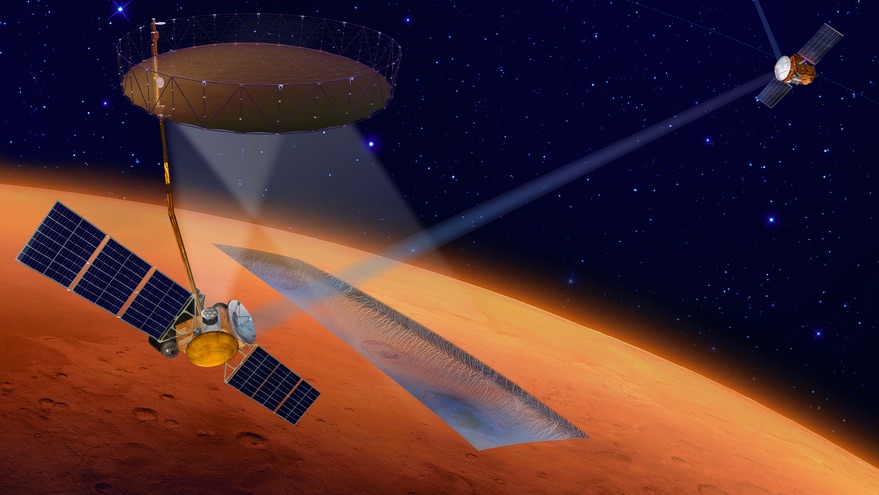WASHINGTON — NASA and three international partners have signed an agreement to cooperate on a proposed mission to search for ice deposits under the surface of Mars, a precursor for human missions there.
In a Feb. 3 statement, NASA said it signed a “statement of intent” with the Canadian Space Agency (CSA), Japan Aerospace Exploration Agency (JAXA) and the Italian space agency ASI regarding the International Mars Ice Mapper. Under that agreement, the agencies will study concepts for the mission and potential roles and responsibilities.
NASA introduced the mission concept in its fiscal year 2021 budget proposal a year ago. The spacecraft would launch as soon as 2026 and go into orbit around Mars, using a radar to search for deposits of ice below the Martian surface that could be studied by future missions to the Martian surface, including human missions.
In its statement, NASA did not disclose the potential roles of the international partners on the mission. However, at past meetings of advisory committees, agency officials said that CSA would provide the radar instrument, JAXA the spacecraft bus and ASI the communications subsystem for the spacecraft. NASA would be responsible for overall mission management and for providing the launch of the spacecraft.
“This innovative partnership model for Mars Ice Mapper combines our global experience and allows for cost sharing across the board to make this mission more feasible for all interested parties,” Jim Watzin, a NASA senior adviser supporting Mars mission planning and former head of the agency’s Mars Exploration Program, said in the statement.
NASA hasn’t set a formal cost estimate for its portion of the mission, but Watzin, speaking at a November meeting of a committee supporting the ongoing planetary science decadal survey, said the agency had estimated its share of the mission will cost $185 million.
At that meeting, Watzin said that Mars Ice Mapper was an essential part of long-term planning for human Mars missions, by identifying locations where water ice may exist within 5-10 meters of the surface and thus could be accessed by crewed expeditions. “The Mars Ice Mapper mission was identified as an essential precursor mission necessary to get that critical information so we could decide where to go for the first human mission, and also how to prepare for that mission,” he said.
The mission has faced some skepticism from Mars scientists, who question the prioritization of an ice-mapping mission over other scientific objectives. Watzin said at that November meeting that Mars Ice Mapper is an “exploration precursor mission” that also has scientific benefits, comparing it to the Lunar Reconnaissance Orbiter mission originally launched to support the Constellation lunar exploration effort but which is now part of NASA’s planetary science program.
In its announcement of the statement of intent, NASA said the partners “will explore mission-enabling rideshare opportunities” in the next phase of study of Mars Ice Mapper. “All science data from the mission would be made available to the international science community for both planetary science and Mars reconnaissance.”
“Mapping near-surface water ice would reveal an as-yet hidden part of the Martian hydrosphere and the layering above it, which can help uncover the history of environmental change on Mars and lead to our ability to answer fundamental questions about whether Mars was ever home to microbial life or still might be today,” Eric Ianson, director of the Mars Exploration Program, said in the statement.
At a Jan. 27 meeting of the Mars Exploration Program Analysis Group, Ianson said that, in addition to the statement of intent, NASA was preparing for a “pre-acquisition strategy meeting” in the near future. That meeting will decide on a lead center for the Mars Ice Mapper mission and other issues before formally starting the mission’s development.
Watzin, speaking at the same meeting, expected a formal memorandum of understanding among the agencies participating in the mission to be ready by late spring or early summer. “That will get the mission team together and then we can begin in earnest moving forward on the implementation of this,” he said.
The NASA announcement of the statement of intent included an illustration of Mars Ice Mapper communicating with three spacecraft in Mars orbit, acting as communications relays back to Earth. The announcement didn’t discuss these relays, but agency officials have previously discussed developing a communications satellite network at Mars, perhaps through public-private partnerships, to support Mars Ice Mapper.
